INFECCIONES DE PIEL Y PARTES BLANDAS Parte 1./INFECTIONS OF THE SKIN AND SOFT PARTS Part 1.
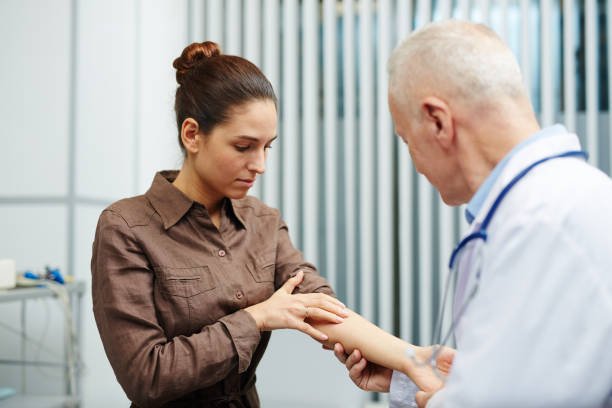
Hola a todos, aquí les traigo mi primera publicación médica, he intentado explicar de forma coloquial algunos términos médicos para que todas las personas que lo lean entiendan y asimilen al 100%. Sólo incluí lo que considero necesario que sepan y así no hacer tan aburrida la lectura y que sea del agrado de la mayoría.
Debo aclarar que este contenido es puramente educativo y que no pretende hacer propaganda de ningún producto, si presenta algún singo o síntoma similar a los descritos en este documento debe acudir al médico y no automedicarse. Sea prudente.
Hello everyone, here I bring you my first medical publication, I have tried to explain in a colloquial way some medical terms so that all the people who read it understand and assimilate 100%. I have only included what I consider necessary for you to know so as not to make the reading so boring and so that most people will like it.
I must clarify that this content is purely educational and is not intended to advertise any product, if you have any symptoms similar to those described in this document you should seek medical advice and not self-medicate. Be prudent.

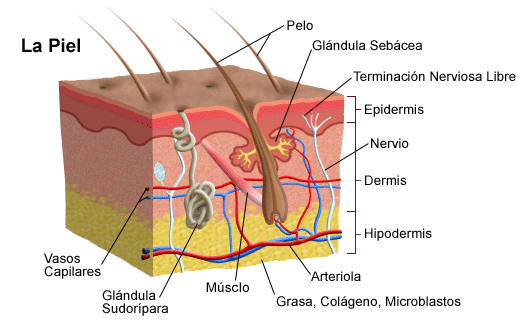
La piel es el órgano más grande del cuerpo.1 Entre sus principales funciones está la protección del organismo de factores externos como bacterias, sustancias químicas y temperatura.
La piel está formada por 3 capas: Epidermis, Dermis e Hipodermis, en ese orden de más externa a más interna. La Epidermis es la capa más externa, protege las capas internas y contiene principalmente a los queratinocitos* y los melanocitos. En la Dermis está el tejido conjuntivo, los vasos sanguíneos, glándulas sebáceas y sudoríparas,2 nervios* y folículos pilosos* principalmente. La Hipodermis es la capa más profunda de la piel, ésta contiene al tejido adiposo conformado por los adipocitos, en otras palabras, es la grasa corporal.
The skin is the largest organ of the body.1 Its main functions include protecting the body from external factors such as bacteria, chemicals and temperature.
The skin is made up of 3 layers: Epidermis, Dermis and Hypodermis, in that order from outermost to innermost. The Epidermis is the outermost layer, protects the inner layers and contains mainly keratinocytes* and melanocytes. The dermis contains connective tissue, blood vessels, sebaceous and sweat glands,2 nerves* and hair follicles* mainly. The hypodermis is the deepest layer of the skin, it contains the adipose tissue made up of adipocytes, in other words, it is the body fat.

Clasificación/Classification
| Tipo de infección | Localización | Type of infection | Location |
|---|---|---|---|
| Impétigo | Epidermis | Impetigo | Epidermis |
| Ectima | Epidermis y dermis | Ecthyma | Epidermis and dermis |
| Foliculitis | Folículo piloso superficial (epidermis) | Folliculitis | Superficial hair follicle (epidermis) |
| Forúnculo | Folículo piloso profundo (dermis) | Furuncle | Deep hair follicle (dermis) |
| Hidrosadenitis | Folículo pilosebáceo-glándulas apocrinas | Hydrosadenitis | Pilosebaceous follicle - apocrine glands |
| Erisipela | Dermis – TCS* (hipodermis) | Erysipelas | Dermis - SCT* (hypodermis) |
| Celulitis | Dermis – TCS (más profundo que el anterior) | Cellulitis | Dermis - TCS (deeper than above) |
| Fascitis necrotizante | Fascia profunda* | Necrotizing fasciitis | Deep fascia* |
| Miositis | Músculo | Myositis | Muscle |

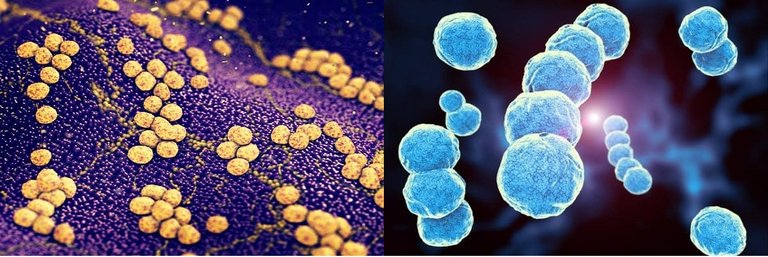
Etiología:
En la gran mayoría de los casos el microorganismo Grampositivo causante de las infecciones es el Staphylococcus aureus y el Streptococcus grupo A beta hemolítico. Ambos están presentes en la piel y la garganta de ahí a que causen afecciones como: forunculosis, faringitis estreptocócica (amigdalitis), fiebre reumática aguda, fiebre escarlata (Escarlatina), glomerulonefritis aguda y fascitis necrotizante.
Etiology:
In the vast majority of cases the Gram-positive microorganism causing infections is Staphylococcus aureus and Streptococcus group A beta hemolytic. Both are present in the skin and throat hence they cause conditions such as: furunculosis, streptococcal pharyngitis (tonsillitis), acute rheumatic fever, scarlet fever (scarlet fever), acute glomerulonephritis and necrotizing fasciitis.

Patogenia:
Como en todas las enfermedades, existen factores que favorecen su ocurrencia, en este caso son los factores del huésped:
- Inmunosupresión.
- Obesidad – Malnutrición.
- Diabetes Mellitus con complicaciones.
- Afectación arterial crónica.
Pathogenesis:
As in all diseases, there are factors that favor its occurrence, in this case they are host factors:
- Immunosuppression.
- Obesity - Malnutrition.
- Diabetes Mellitus with complications.
- Chronic arterial involvement.

Para hacer el diagnóstico debemos tener en cuenta:
Diagnóstico clínico:
- Determinar la profundidad de la lesión.
- Determinar complicaciones: estructuras involucradas, necrosis, etc.
- Determinar el grado de afectación sistémica.
Diagnóstico microbiológico:
Cultivo mediante aspiración y/o torunda; especialmente si… :
- Se sospecha de infección por patógenos multiresistentes.
- Hay mala respuesta a tratamientos previos.
- Existen heridas de larga evolución.
To make the diagnosis we must take into account:
Clinical diagnosis:
- Determine the depth of the lesion.
- Determine complications: structures involved, necrosis, etc.
- Determine the degree of systemic involvement.
Microbiological diagnosis:
Culture by aspiration and/or swab; especially if... :
- There is suspicion of infection by multiresistant pathogens.
- There is poor response to previous treatments.
- There are wounds of long evolution.

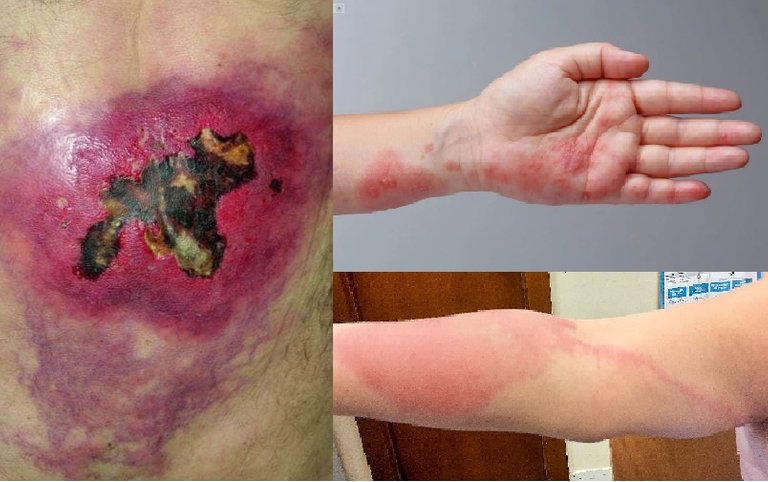
Signos y Síntomas - Semiología clínica / Signs and Symptoms - Clinical Semiology
| Infección leve | Presencia de ≥ 2 signos de inflamación: pus, eritema*, dolor y/o calor. Afectación de piel y tejido subcutáneo. Sin complicaciones sistémicas*. | Mild infection | Presence of ≥ 2 signs of inflammation: pus, erythema*, pain and/or heat. Skin and subcutaneous tissue involvement. No systemic complications*. |
| Infección moderada | Infección estable con uno de los siguientes signos: celulitis > 2 cm, linfangitis ascendente, extensión a fascia superficial, absceso profundo, gangrena y afecta a músculos, tendones, articulaciones o hueso. | Moderate infection | Stable infection with one of the following signs: cellulitis > 2 cm, ascending lymphangitis, extension to superficial fascia, deep abscess, gangrene and involvement of muscles, tendons, joints or bone. |
| Infección grave | Infección con repercusión sistémica o inestabilidad hemodinámica*. | Severe infection | Infection with systemic repercussion or hemodynamic instability*. |

Llegados a éste punto si les ha parecido interesante háganmelo saber en los comentarios, en la próxima publicación continuaremos con éste tema, profundizaremos en la clínica y el tratamiento de las Infecciones superficiales y profundas de la piel, infección de heridas quirúrgicas e infecciones del pie diabético. Muchas gracias por el interés, hasta la próxima.
At this point if you have found it interesting let me know in the comments, in the next publication we will continue with this topic, we will deepen in the clinic and treatment of superficial and deep skin infections, surgical wound infection and diabetic foot infections. Thank you very much for your interest, see you next time.

GLOSARIO:
*Queratinocitos: células que producen queratina, sustancia que impermeabiliza y fortalece la piel.
*Melanocitos: células que producen melanina, principal pigmento responsable del color normal de la piel y el cabello. 3
*Tejido conjuntivo: sostiene, protege y estructura otros tejidos y órganos del cuerpo, almacena grasa, ayuda a desplazar nutrientes y otras sustancias entre los tejidos y los órganos, además de reparar daños en los tejidos.
*Vasos sanguíneos: son como una red de cañerías por los que circula la sangre que suministra oxígeno y nutrientes a todas las partes del cuerpo y elimina los productos de desecho.
*Glándulas sebáceas y sudoríparas: sintetizan el sebo para hidratar la piel, aportarle los antioxidantes que necesita y protegerla de los gérmenes.
*Nervios: comunican los centros nerviosos con todos los órganos del cuerpo. 4
*Folículos pilosos: estructura con forma de saco en donde nace el pelo.
*Adipocitos: células que almacena la energía en forma de grasa.
*TCS: tejido celular subcutáneo.
*Fascia profunda: es un entramado de tejido conjuntivo que interconecta todas las estructuras de nuestro cuerpo.
*Vaso linfático: Tubo delgado que transporta líquido linfático y glóbulos blancos por el sistema linfático.
*Cuando hablamos de complicaciones sistémicas nos referimos a que se afecta al cuerpo entero, en lugar de una sola parte o un solo órgano.
*eritema: enrojecimiento de la piel condicionado por una inflamación. 5
*Inestabilidad hemodinámica: se puede identificar mediante diversos signos y síntomas, por ejemplo: alteración del estado de conciencia, dolor torácico, disnea, hipo/hipertensión arterial, taquicardia, etc.
GLOSSARY:
*Keratinocytes: cells that produce keratin, a substance that waterproofs and strengthens the skin.
*Melanocytes: cells that produce melanin, the main pigment responsible for normal skin and hair color. 3
*Connective tissue: supports, protects and structures other tissues and organs of the body, stores fat, helps move nutrients and other substances between tissues and organs, and repairs tissue damage.
*Blood vessels: are like a network of pipes through which blood circulates, supplying oxygen and nutrients to all parts of the body and eliminating waste products.
*Sebaceous and sweat glands: synthesize sebum to moisturize the skin, provide it with the antioxidants it needs and protect it from germs.
*Nerves: communicate the nerve centers with all the organs of the body. 4
*Hair follicles: sac-like structure where the hair grows.
*Adipocytes: cells that store energy in the form of fat.
*SCT: subcutaneous cellular tissue.
*Deep fascia: a network of connective tissue that interconnects all the structures of our body.
*Lymphatic vessel: thin tube that transports lymphatic fluid and white blood cells through the lymphatic system.
*When we speak of systemic complications we mean that the whole body is affected, rather than a single part or organ.
*erythema: reddening of the skin due to inflammation. 5
*Hemodynamic instability: can be identified by various signs and symptoms, e.g. altered state of consciousness, chest pain, dyspnea, hypo/hypertension, tachycardia, etc.

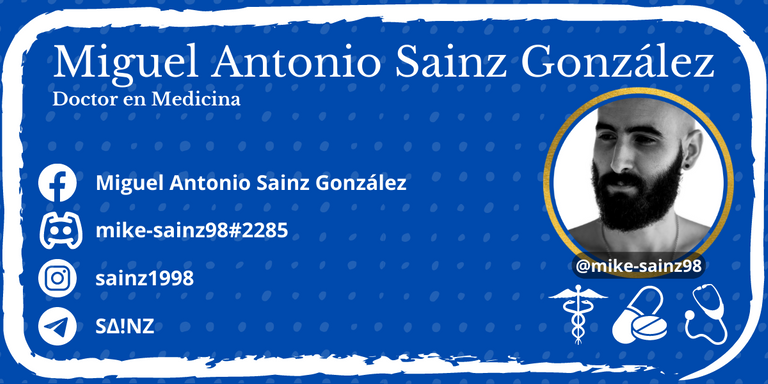
Las imágenes utilizadas son de distintos sitios y personalizadas por mi para una mejor presentación.
The images used are from different sites and customized by me for a better presentation.
PIXABAY
Stanford Medicine Children’s Health
Betelgeux
Diagnostico en casa
MSD Manuals
Top Doctors
El Parte de Confirmación
Los separadores y el banner que utilicé son creados por mi en CANVA
La traducción del contenido fue hecha desde DeepL Translate.
The separators and the banner I used are created by me in CANVA
The translation of the content was done from DeepL Translate.
BIBLIOGRAFÍA/BIBLIOGRAPHY
Has sido votado por
PROYECTO ENLACE
'Conectando Ideas y Comunidades'
PROYECTO ENLACE es un proyecto de curación de habla hispana enfocado en recompensar contenido de calidad y apoyar autores en su proceso de crecimiento en HIVE.
Creemos y apostamos por el futuro de esta gran plataforma, y estamos muy emocionados de poder hacerla crecer junto a esta comunidad. Así que te invitamos a publicar en nuestra COMUNIDAD y estar atento a todas las actividades que tenemos preparadas y que estaremos publicando en breve.
¿QUIERES AUTOMATIZAR TUS GANANCIAS DE CURACIÓN? SE PARTE DEL PROYECTO ENLACE APOYANDO A NUESTRO TRAIL EN HIVE.VOTE INGRESA AQUÍ PARA CONOCER LOS DETALLES.
¿QUIERES INVERTIR ENLACE? DESCUBRE COMO HACERLO Y GENERAR INGRESOS DE FORMA SEMANAL MEDIANTE TU DELEGACIÓN DE HP AQUÍ TE EXPLICAMOS COMO.
Te invitamos a participar en nuestro servidor de Discord: https://discord.gg/3S9y7BbWfS
Atentamente
EQUIPO ENLACE 2023
Gracias una vez más, excelente proyecto.
Congratulations @mike-sainz98! You have completed the following achievement on the Hive blockchain And have been rewarded with New badge(s)
Your next target is to reach 50 replies.
You can view your badges on your board and compare yourself to others in the Ranking
If you no longer want to receive notifications, reply to this comment with the word
STOPCheck out our last posts:
Support the HiveBuzz project. Vote for our proposal!
Wiiiiiiii! Victory.
De nada @mike-sainz98.
Por cierto, también necesitamos tu ayuda. ¿Podemos pedirle que apoye nuestra propuesta para que nuestro equipo pueda continuar con su trabajo?
Puedes hacerlo en peakd, ecency, Hive.blog o con HiveSigner.
https://peakd.com/me/proposals/248
¡Muchas gracias!
Un post bastante educativo, gracias por compartir esta información tan importante!
Me alegra saber que te gustó. Eso me motiva mucho para seguir adelante. Saludos.